The NVIDIA GeForce GTX 1080 Preview: A Look at What's to Come
by Ryan Smith on May 17, 2016 9:00 AM ESTGaming Performance, Power, Temperature, & Noise
So with the basics of the architecture and core configuration behind us, let’s dive into some numbers.
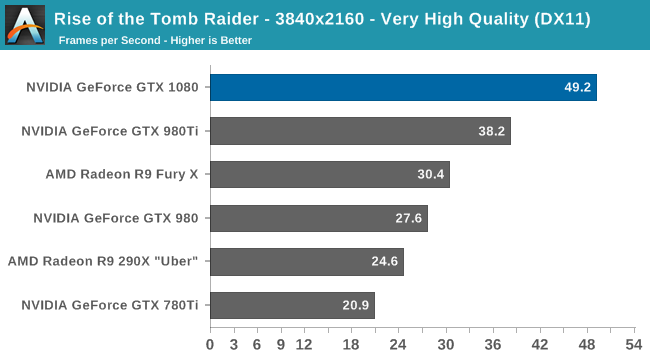

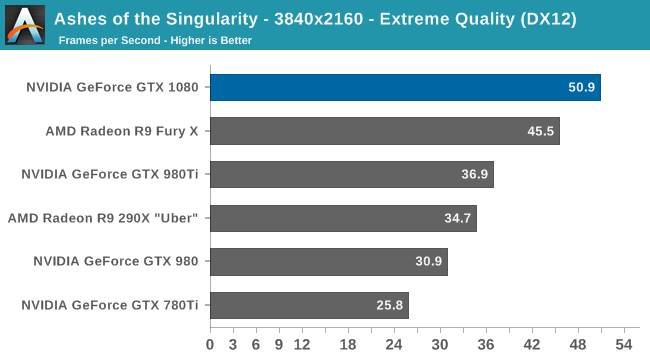

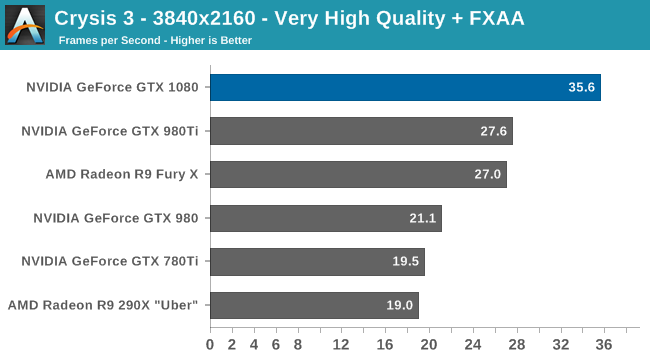
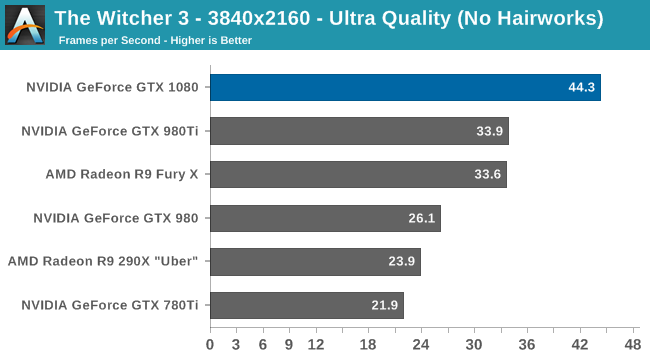
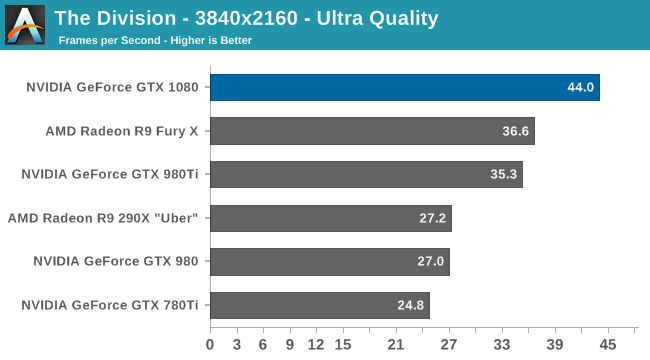
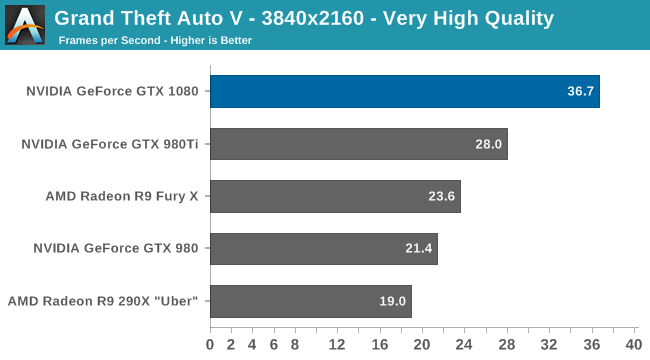
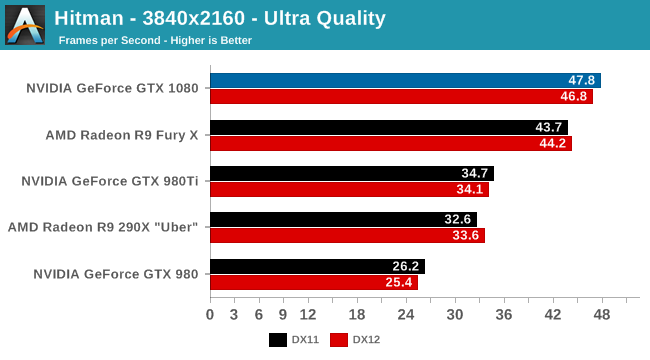
As the first high-end card of this generation to launch, NVIDIA gets to set the pace for the market. At the risk of being redundant the GTX 1080 is now the fastest single-GPU card on the market, and even at 4K it wins at every single gaming benchmark, typically by a good margin. In practice we’re looking at a 31% performance lead over GTX 980 Ti – the card the GTX 1080 essentially replaces – with a similar 32% lead over AMD’s Radeon R9 Fury X. Meanwhile against the slightly older GTX 980, that gap is 70%.
On a generational basis this ends up being very close to the 74% jump in 4K performance going from the GTX 680 to GTX 980. And although the pricing comparison is not especially flattering for NVIDIA here, it should be evident that NVIDIA isn’t just looking to sell GTX 1080 as an upgrade for high-end Kepler cards, but as an upgrade for GTX 980 as well, just 20 months after it launched.
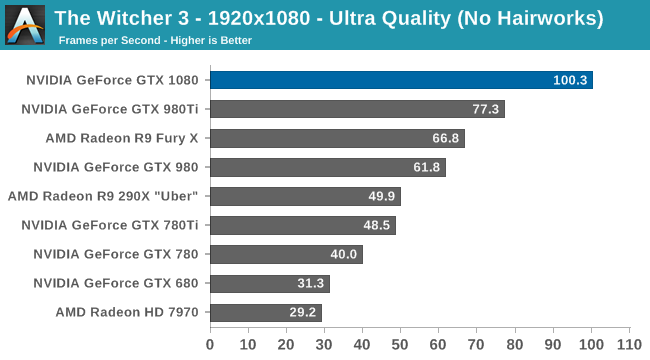
I also wanted to quickly throw in a 1080p chart, both for the interest of comparing the GTX 1080 to the first-generation 28nm cards, and for gamers who are playing on high refresh rate 1080p monitors. Though this will of course vary from game to game, roughly speaking the GTX 1080 should be 3x faster than the GTX 680 or Radeon HD 7970. This is a good reminder of how architectural efficiency has played a greater role in past years, as this is a much larger gain than we saw jumping from 55nm to 40nm or 40nm to 28nm, both of which were much closer to the historical norm of 2x.

Meanwhile when it comes to power, temperature, and noise, NVIDIA continues to execute very well here. Power consumption under Crysis 3 is some 20W higher than GTX 980 or 52W lower than GTX 980 Ti, generally in line with NVIDIA’s own TDP ratings after accounting for the slightly higher CPU power consumption incurred by the card’s higher performance. The end result is that GTX 1080 is a bit more power hungry than GTX 980, but still in the sweet spot NVIDIA has carved out in the gaming market. Broadly speaking, this amounts to a 54% increase in energy efficiency in the case of Crysis 3.
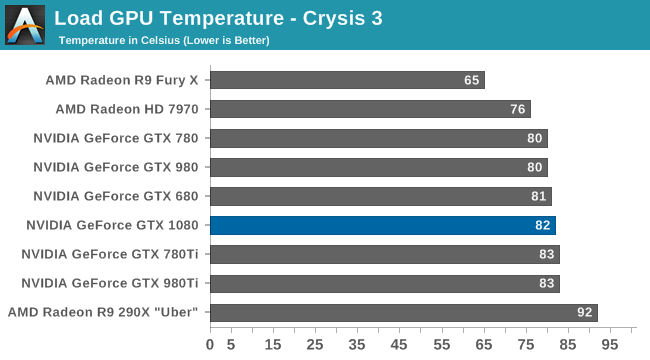
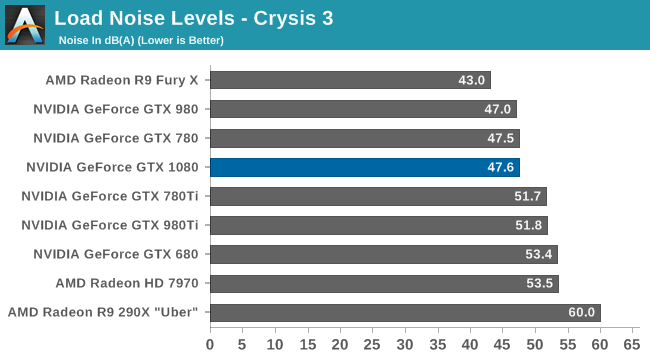
Otherwise from a design perspective the GTX 1080 Founders Edition carries on from NVIDIA’s high-end GTX 700/900 reference design, allowing NVIDIA to once again offer a superior blower-based solution. NVIDIA’s temperature management technology has not changed relative to Maxwell, so like their other cards, the GTX 1080 tops out in the low 80s for load temperature. More significantly, at 47.5 db(A) load noise, the card is on par with the GTX 780 and half a dB off of the GTX 980.
Ultimately NVIDIA has designed the GTX 1080 to be a drop-in replacement for the GTX 980, and this data confirms just that, indicating that GTX 1080’s much higher performance comes with only a slight increase in power consumption and no meaningful change in temperatures or acoustics.


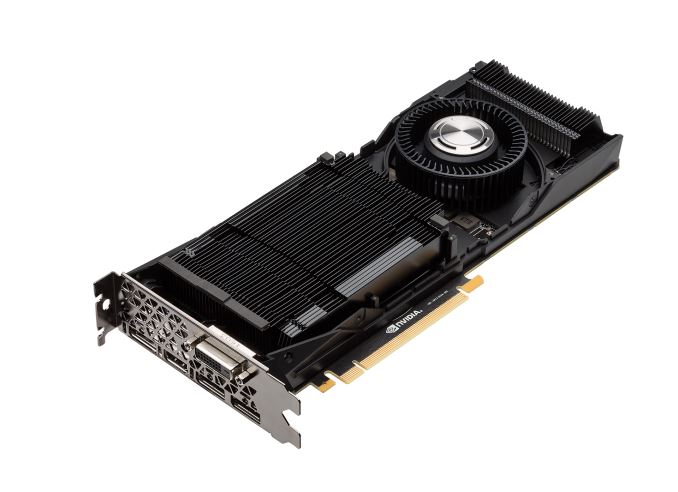








262 Comments
View All Comments
bananaforscale - Wednesday, May 18, 2016 - link
Early adopter tax.nagi603 - Tuesday, May 17, 2016 - link
So much for a fury x price cut...just4U - Wednesday, May 18, 2016 - link
likely about $1200 in Canada.. uh.. no.qasdfdsaq - Tuesday, May 17, 2016 - link
As long as the follow up doesn't go the way of part 2 of Galaxy S7 review... 2.5 months and no news or updates. Mhmm.milkywayer - Tuesday, May 17, 2016 - link
I'm jaw-dropped by performance jump.Guess what's going to replace my 970 in a month? (assuming I'll be able to find the damn thing even with another +$100 premium here in Pakistan)
cknobman - Tuesday, May 17, 2016 - link
Performance improvement is nice but not jaw dropping.Honestly I think Nvidia has left the door open for AMD to take control of the high end later this year with the new Fury line.
I'll be waiting on making a purchase.
ChefJeff789 - Tuesday, May 17, 2016 - link
Later this year? AMD has said that Vega is not coming until next year. I'd be shocked to see it sooner.zoxo - Tuesday, May 17, 2016 - link
There are rumours that AMD might come out with Vega this October. Then again the GP100 chip can be released to the consumer space early too if NVidia feels the need to respond. All in all, I'm hoping for pretty darn amazing high-end MXM cards from both sides. This generation is rather exciting!Yojimbo - Tuesday, May 17, 2016 - link
There are always rumors of AMD releasing something. There were rumors that the Fury cards would be released up to 9 months before they were eventually released. For the past few years AMD's release schedules go backwards, not forwards. I'll believe a 2016 Vega release when I see it. Did AMD even say when in 2017 Vega is supposed to arrive? They have it sitting there at the very beginning of 2017 in their slide graphic, but that's hardly something they'd have any trouble ignoring (in terms of PR) if it actually comes out in Q2 2017.zoxo - Tuesday, May 17, 2016 - link
Well, they have a lot of wiggle room in this. If they release it early, it means lower yields, which means lower initial margins, and possibly lower out of the box clock speeds, but they do get the performance crown (at least before the 1080Ti is released). They can however release it early, then release a 'GHz' edition after Ti is out to compete with it as needed.